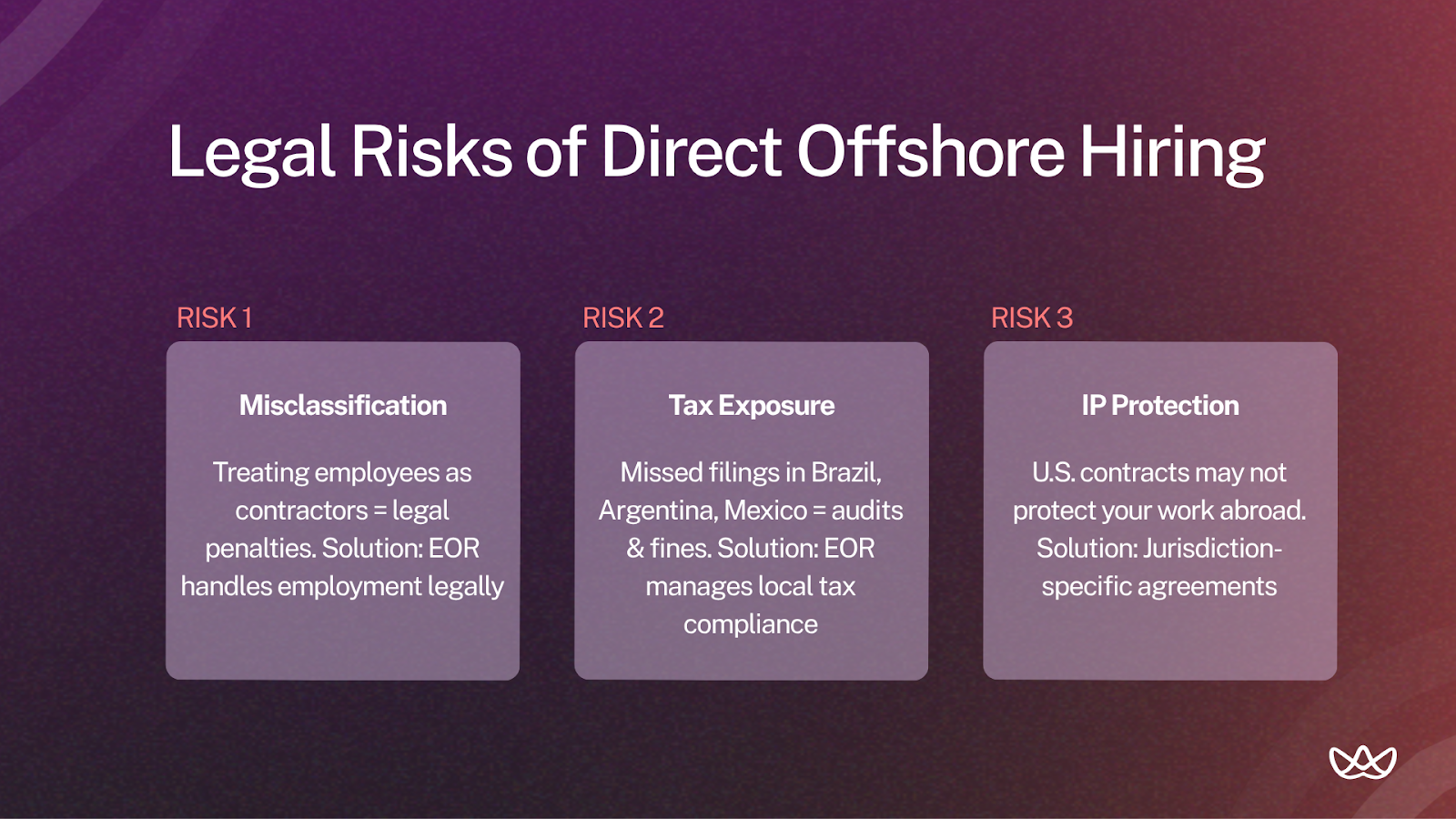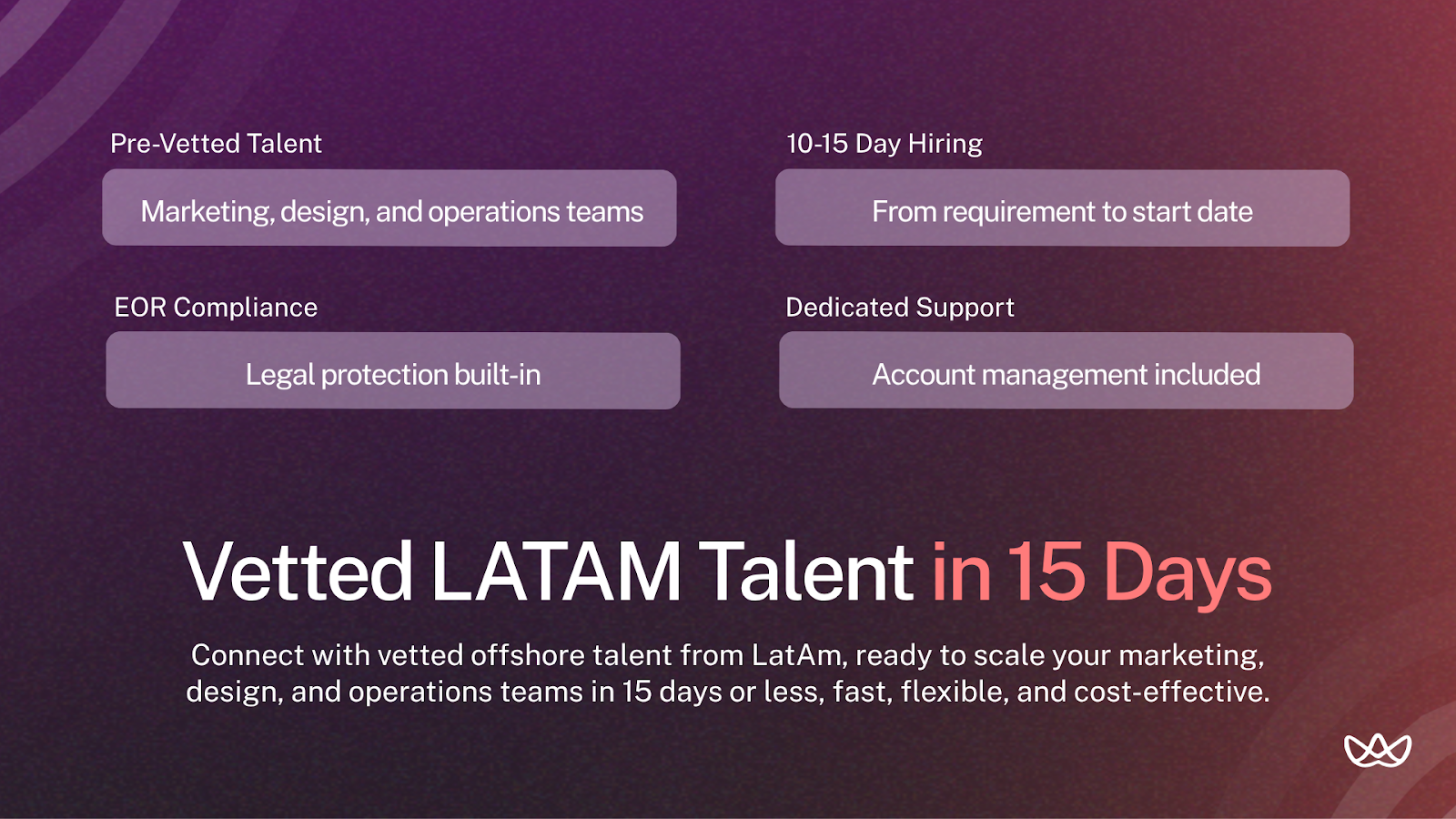Hiring offshore staff allows companies to build teams outside their home country. It provides access to skilled talent at lower costs while maintaining productivity.
Asia has long been the dominant region for offshore hiring. LATAM is becoming a more common choice for U.S. agencies because of overlapping time zones, bilingual professionals, and experience in marketing and creative roles.
Today, agencies can hire through freelance marketplaces, direct contracts, or fully managed EOR platforms. Or hire through providers focused on pre-vetted LATAM professionals, which makes recruitment, compliance, and payroll easier to manage.
Let’s look at offshore staffing solutions for agencies and explain how LATAM professionals can be integrated into U.S. teams in 2025.
Offshore Hiring Models Overview (2025)
Why Companies Hire Offshore Staff (Benefits & Risks Explained)
Offshore staffing can lower labor costs. For example, a mid-level marketing specialist in the U.S. typically earns $65,000 to $85,000 per year. The same role in Latin America costs roughly $24,000 to $42,000. Even after considering platform fees and management overhead, the difference is significant.
Cost isn’t the only factor. Hiring outside your local market gives access to talent that may be hard to find nearby. A bilingual content strategist with SaaS experience, for instance, is often easier to find in Buenos Aires or Mexico City than in most U.S. regions outside major tech centers.
There are risks to consider. Quality control can be more difficult when you’re not onsite. Time zone differences may slow collaboration if not planned for. Communication gaps can appear when English proficiency varies or cultural context isn’t fully understood.
Offshore Staffing Benefits vs. Risks:
Key Takeaway: Offshore staffing saves costs and adds flexibility, but depends on the right partner, vetted talent, and managing cultural and security issues. LATAM works well for overlapping hours.
Legal Risks of Direct Offshore Hiring for Agencies

1. Compliance & Worker Classification Risks
Misclassifying offshore workers as independent contractors can create legal issues. U.S. authorities consider how much control you have over the worker’s schedule, tools, and daily tasks. If you direct their work closely, the person may be treated as an employee under U.S. law, even if they live abroad.
Using an Employer of Record (EOR) can reduce this risk by handling the employment relationship in the worker’s home country while you manage the work itself.
2. Tax Exposure & Payroll Liability
Hiring offshore staff requires attention to local tax rules. Countries like Brazil, Argentina, and Mexico have reporting and withholding requirements that differ from the U.S. Missing a filing or miscalculating withholding can trigger audits or penalties.
The complexity increases when hiring across multiple countries, as social security, benefits, and termination rules vary.
3. Contract & IP Protection Challenges
Contracts should clearly define ownership of work and intellectual property across jurisdictions. Standard U.S. work-for-hire clauses may not apply in countries like Colombia or Chile. It’s important to have agreements that comply with local law while protecting your agency’s work product.
Using a provider with built-in EOR services can simplify payroll and compliance across LATAM, ensuring local requirements are met without adding administrative burden.
Top 11 Platforms to Hire Offshore Staff in 2025
Here’s an overview of the main options for offshore hiring in 2025.
1. Floowi
Best for: Vetted LATAM marketing, design, and operations talent.
Floowi focuses specifically on Latin American professionals who've been pre-screened for English fluency, technical skills, and agency work experience.

The platform handles EOR compliance and provides dedicated account management. Typical time-to-hire runs 10-15 days from requirement to start date.
2. Deel
Best for: Global compliance, payroll, and contractor management.
Deel operates as a global payroll platform rather than a talent marketplace. You find the person, Deel handles the paperwork. It supports over 150 countries with localized contracts and tax compliance.
The platform doesn't vet candidates, which means you manage the entire hiring process yourself.
3. Turing
Best for: Pre-vetted software engineers for long-term projects.
Turing uses AI-matching to connect companies with developers who've passed technical assessments. The focus is purely on engineering roles.
Talent comes primarily from India, Eastern Europe, and Latin America. Vetting includes coding tests and English proficiency checks.
4. Andela
Best for: Accessing high-quality technical talent from emerging markets.
Andela started in Africa and expanded globally. The platform curates technical specialists through a multi-stage vetting process. Pricing sits higher than generalist platforms because of the hands-on matching and quality control.
5. DistantJob
Best for: Full-time offshore hires through direct placement.
DistantJob acts as a recruitment agency for offshore positions. They find candidates, you interview and hire them directly. The service includes some ongoing HR support, but you handle the employment relationship yourself after placement.
6. OnlineJobs.ph
Best for: Administrative and support roles from the Philippines.
This platform connects companies with Filipino workers for virtual assistant, customer support, and administrative roles. There's no vetting process. You post jobs, review applications, and manage everything yourself. It works well for high-volume, lower-complexity roles.
7. Supersourcing
Best for: Verified offshore software development teams.
Supersourcing focuses on connecting companies with development agencies rather than individual contractors. You get entire teams with established processes. This works when you need to scale development quickly without building infrastructure.
8. Hubstaff Talent
Best for: Free global directory of remote professionals.
Hubstaff Talent operates as a free job board where remote workers create profiles. There's no vetting, no compliance support, and no quality control. You handle everything from sourcing to contracts to payroll.
9. Remote.com
Best for: International payroll and HR compliance.
Remote.com competes directly with Deel as an EOR platform. Similar structure where you source talent and they handle employment compliance. The platform supports benefits administration and local HR expertise in each market.
10. Workana
Best for: Latin American freelancers for marketing and creative work.
Workana operates as a project-based marketplace similar to Upwork but focused on Spanish and Portuguese-speaking freelancers. Quality varies widely since there's no pre-vetting. Payment protection and dispute resolution are built in.
11. Upwork
Best for: Flexible project-based offshore hiring.
Upwork remains the largest freelance marketplace globally. You'll find every skill level and price point. The lack of vetting means you spend significant time reviewing profiles and managing trial projects. Best suited for short-term work where you can afford some trial and error.
How to Choose the Right Offshore Hiring Platform for Your Needs
Start with the role. Engineers need technical checks. Marketing and creative hires need portfolio and communication review. Admin roles need reliability and basic tool skills.
Compliance becomes important once you hire more than a few people. Contracts, taxes, and local rules take time.
Time zones matter too. Three hours lets teams work together. Twelve hours means mostly asynchronous work.
Cost isn’t only the hourly rate. Include vetting, management, and replacement costs. Paying a bit more for vetted talent usually avoids problems later.
Offshore Direct Hiring vs. Floowi Nearshore LATAM Talent
1. Vetting & Talent Quality
Direct offshore hiring puts the entire vetting burden on you. You write the job post, screen applications, conduct interviews, check references, and run test projects. This works if you have HR capacity and know how to assess skills across cultural contexts.
Floowi pre-vets candidates for English proficiency, relevant skills, and professional experience before they enter the talent pool. The platform focuses on marketing, design, and digital/creative roles that agencies typically hire for, making it easier to find qualified candidates without managing the full vetting process yourself.
2. Time-to-Hire & Scalability
Direct hiring typically takes 45-60 days from job posting to start date. You're navigating foreign job boards, dealing with time zone scheduling for interviews, and handling contract negotiations across language barriers.
Floowi reduces this to 10-15 days by maintaining a vetted talent pool and handling the administrative work. When you need to scale quickly or replace someone who didn't work out, that time difference matters.
3. Legal Protection & Compliance
With direct hiring, you need to understand employment law in each country where you hire. Termination rules differ dramatically between Colombia and Argentina. Benefits requirements vary. Tax filing deadlines don't align.
Floowi includes EOR compliance through partnerships that handle country-specific requirements. You manage the work, they manage the employment relationship in a legally compliant way.
4. Cost Predictability & Retention
Direct offshore hiring can seem cheaper at first, but hidden costs add up. Failed hires, legal mistakes, and high turnover increase replacement and management costs.
Floowi uses a flat monthly fee that covers salary, local taxes, benefits, payment processing, HR support, and replacements. There are no setup costs or long-term commitments, and pricing is transparent by role and experience. Recruitment system combines data-driven matching with human vetting to find qualified candidates quickly, providing stability and reducing churn compared with project-based freelance hires.
Best Offshore Hiring Destinations in 2025 (by Region & Role)
LATAM works well for marketing and bilingual roles, Eastern Europe for development, India for IT, and the Philippines for support. Time zones and costs differ, so choose based on what you actually need.
Latin America - Creative and Bilingual Marketing Professionals
LATAM offers the strongest combination of factors for U.S. agencies. Time zones align from Eastern to Pacific. English proficiency is high among professionals. Cultural understanding of U.S. business practices reduces friction.

Countries like Argentina, Mexico, Colombia, and Chile produce strong marketing and design talent. Rates for mid-level roles are $20-35 per hour, lower than U.S. equivalents.
This region works well for bilingual marketing and creative roles that need to connect with U.S. audiences.
Eastern Europe - Technical Expertise
Poland, Romania, and Ukraine offer excellent technical talent, particularly for complex engineering projects. Time zones create some challenges with 7-9 hour differences from U.S. coasts.
Rates run $25-40 per hour. Quality is consistently high, but communication can be more formal and direct than U.S. teams expect.
India - IT and Development
India remains the largest offshore market for software development and IT support. The talent pool is massive, but quality varies significantly. Time zone differences of 10-12 hours make real-time collaboration difficult.
Rates range from $15-25 per hour for mid-level developers. You'll spend more time managing communication and alignment, but the cost savings can justify it for the right projects.
Philippines - Customer Support and Admin Roles
The Philippines provides customer support and administrative staff with strong English skills. Time differences of 12–13 hours limit real-time collaboration. Rates are $10–20 per hour, making it suitable for roles that can work independently.
Other Emerging Markets
Africa, particularly Nigeria, Kenya, and South Africa, is growing as a tech talent source. Quality is improving but infrastructure challenges remain in some areas.
How to Choose the Right Offshore Location for Your Staff
Match the location to the role requirements. Marketing and creative work benefits from LATAM's cultural alignment and time zone overlap. Pure technical roles without heavy collaboration can work from anywhere with strong technical education.
Consider the management overhead. Larger time zone gaps require more asynchronous work, better documentation, and clearer processes. If your team isn't set up for that, prioritize regions with working hour overlap.
How to Hire Offshore Staff Step-by-Step (Process & Checklist)
1. Define Roles and Skills Needed
Be specific about the role. Instead of “marketing help,” define “Content marketer who writes SEO blog posts for B2B SaaS companies.” List the tools they’ll use, the work they’ll deliver, and how you’ll track results.
2. Choose the Right Platform or Partner
Evaluate platforms based on your specific needs, not generic rankings. If you're hiring multiple people across different countries, an EOR platform makes sense.
For a single LATAM marketing hire, a vetted talent platform reduces time and risk.
3. Vet and Interview Candidates Thoroughly
Test for the actual skills the role requires. Give a writing test for content roles. Review design portfolios. Have engineers complete coding exercises.
Generic interview questions tell you little about work quality.
4. Check Portfolios and References
Past work samples show you more than interviews. Look for consistency in quality and relevance to your industry. References should come from direct managers, not just colleagues who can vouch that someone is nice to work with.
5. Set Clear Communication and Reporting Channels
Establish how often you'll meet, which tools you'll use, and what information needs to be communicated proactively versus on request. Unclear expectations cause most offshore relationship failures.
6. Onboard Effectively and Share Culture Early
Spend the first week on context, not output. Share company values, client examples, and team dynamics. Introduce them to key stakeholders. This investment pays off in faster ramp-up and better cultural fit.
7. Establish Measurable KPIs
Define success metrics before work starts. Number of blog posts completed, design concepts delivered, code commits merged, or whatever makes sense for the role. Track these consistently.
8. Invest in Ongoing Training and Feedback
Schedule regular feedback sessions beyond just project check-ins. Share what's working and what needs adjustment. Provide training on your specific processes and tools.
Preparing Your Onshore Team for Offshore Collaboration
For offshore staffing to succeed, your onshore team must adapt workflows and communication.
1. Clarify Responsibilities and Ownership
Define who is responsible for what before the offshore team starts. Unclear ownership leads to frustration when tasks get assumed by others. Document decision-making authority.
For example, can a marketer publish a blog post directly, or does it require review? These details prevent bottlenecks.
2. Set Communication and Workflow Standards
Agree on response times. Is 24 hours acceptable, or do urgent items need same-day replies?
Establish meeting norms: should cameras be on, or are calls during commuting fine? Small clarifications avoid misunderstandings.
3. Build Cross-Border Team Synergy
Include offshore members in relevant meetings, not just status updates. They need context on why decisions are made, not just what the decisions are. Recognize contributions publicly. Offshore team members can feel invisible, so mention their work in meetings and company updates.
Key Takeaway: Offshore success depends on well-structured internal processes, not just having the right talent.
How to Measure Offshore Staffing Success (KPIs & ROI)
1. Productivity and Output Metrics
Track what gets delivered against the time invested. For content roles, measure articles published per week. For design, monitor concepts delivered or revisions needed. For development, look at story points completed or features shipped.
Compare output to onshore team members doing similar work. The goal is consistent results, not just lower-cost output.
2. Quality and Performance Metrics
Error rates matter more than volume. Ten blog posts with factual mistakes create more work than they save.
Track revisions required and client feedback on deliverables. Meeting reliability is also important: do offshore team members meet deadlines and come prepared?
3. Cost Efficiency and ROI Metrics
Include all costs: platform fees, management time, and any tools or licenses. Compare this to local hiring or outsourcing to U.S. agencies. Factor in time saved if roles are filled faster. Filling a position in 15 days instead of 90 avoids lost productivity.
4. Benchmarks for Evaluating Offshore Team Performance
Expect output quality comparable to local hires. Lower rates shouldn’t mean accepting lower standards. Many offshore professionals deliver high-quality work at lower costs. Aim for 40-60% cost savings after accounting for all overhead. If savings are minimal, the added management effort might not be worth it.
Getting Started
Hiring offshore staff works when you approach it like any other team expansion: define what needs to get done, make sure responsibilities are clear, and check in regularly. Start small, learn what works, and adjust as you go.
Done right, LATAM professionals can become a reliable part of your team without adding headaches.
Hire offshore staff in LATAM with Floowi’s nearshore offshore staffing solutions and bring vetted professionals into your agency today.
Frequently Asked Questions
What's the ROI of hiring offshore staff compared to local hires?
Most agencies see 40-60% cost savings on equivalent roles after factoring in platform fees and management overhead. A $70,000 U.S. marketing role typically costs $28,000-35,000 offshore in LATAM with similar output quality.
What's the difference between staffing platforms and EOR services like Deel?
Staffing platforms find talent and often include EOR services. Pure EOR platforms handle compliance and payroll for people you source yourself. If you have HR capacity to recruit, EOR works. If you need help finding qualified candidates, vetted staffing platforms save time.
Which platform has the largest talent pool in Latin America?
Floowi, Workana, and Upwork are key options. Floowi focuses specifically on vetted marketing, design, and digital/creative talent in LATAM, making it easier to find candidates suited to agency needs quickly.
What are the platform fees on top of offshore staff salaries?
Fees range from 15-30% of salary depending on services included. EOR compliance, HR support, and talent vetting cost more than simple job boards. Factor total cost, not just the hourly rate.
Which platforms handle employment contracts and legal compliance?
Deel, Remote.com, and Floowi provide EOR services that manage contracts and compliance. Freelance platforms like Upwork and Workana don't handle employment relationships at all.
Do offshore platforms provide onboarding support?
Full-service platforms like Floowi include onboarding guidance and ongoing account management. Marketplace platforms provide none. You're responsible for the entire relationship after hire.
How long does it take to hire through offshore platforms?
Timeline depends on whether talent is pre-vetted. Vetted platforms like Floowi typically deliver candidates in 10-15 days. Self-service platforms take 45-60 days because you handle all sourcing and vetting.


.png)
.png)






.png)
.png)

